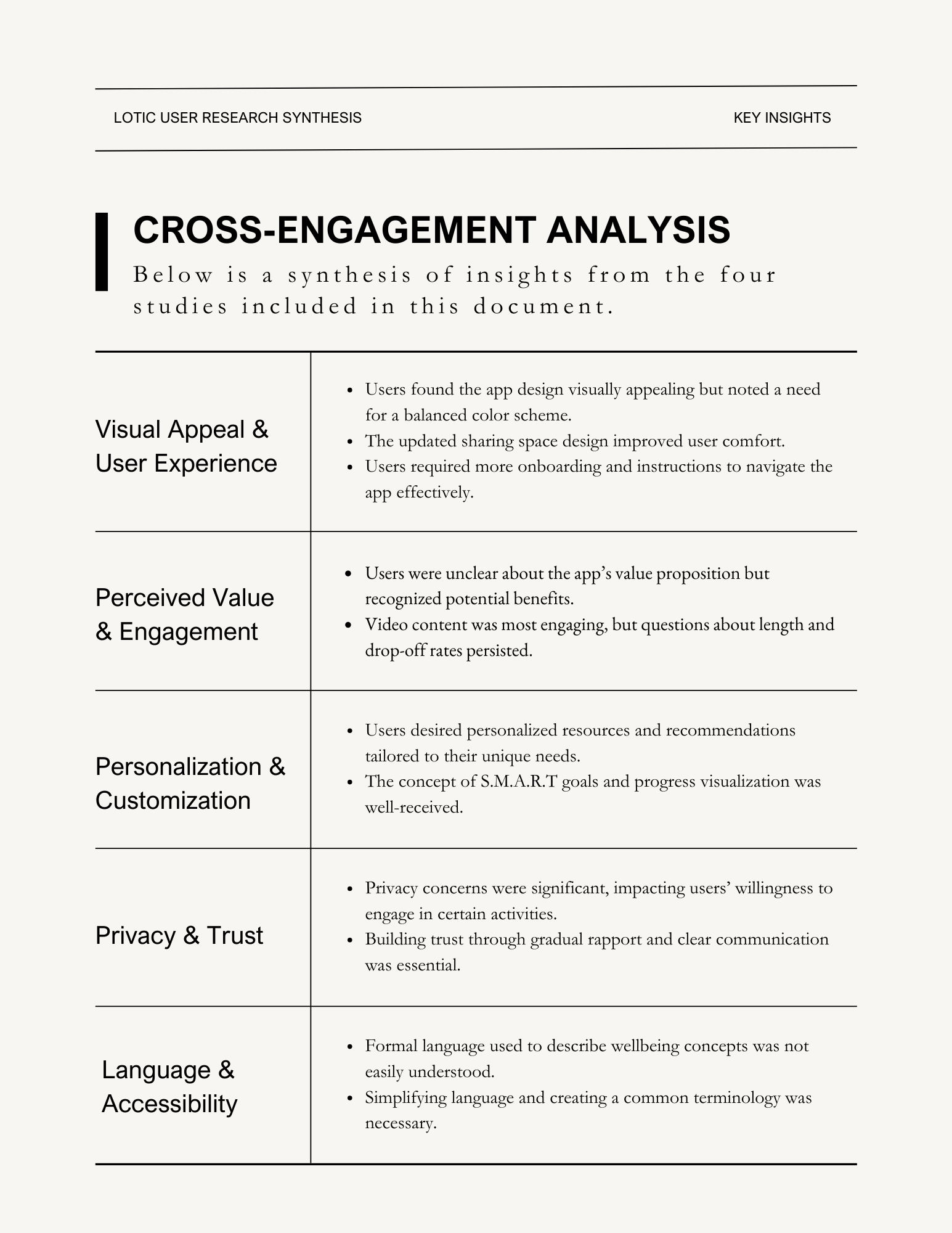UX Research Synthesis
UX Research Synthesis
research period: september 2022-april 2023
Collective synthesis conducted: june 2023
Overview
Over seven months of in-depth UX research and testing were conducted to refine the design and functionality of Lotic’s Talk2Me mobile application. Engaging both college students and the general population, the research included a variety of methods such as interviews, surveys, and concept tests. The aim was to understand user needs, preferences, and the perceived value of the app. This case study presents synthesized findings, actionable recommendations, and their implications, providing a crucial resource for guiding current design efforts and informing future app iterations.
KEY FINDINGS
RECOMMENDATIONS
Approach
Research Activities
College Student Research (August - November 2022):
Methods: Remote and in-person interviews, supplementary surveys.
Participants: 37 interview participants, 150 survey respondents.
Focus: Understanding motivations, values, pain points, wellbeing practices, support networks, resource availability, and technology preferences.
TalkFaster Concept Test (February 2023):
Methods: Remote, unmoderated concept test.
Participants: 9 test participants.
Focus: Evaluating the effectiveness of the TalkFaster design and its impact on user engagement.
Visual and Motion Graphics Content Test (February 2023):
Methods: Preference tests for content formats and visual styles.
Participants: 24 test participants.
Focus: Determining preferred visual design for content delivery and format preferences.
Talk2Me Concept Test (February - March 2023):
Methods: In-person concept test.
Participants: 9 participants (college students and general population).
Focus: Assessing the viability and user engagement of Talk2Me concepts.
Synthesis & Analysis
The synthesis and analysis process involved affinity diagramming to collate findings from each research activity. This method allowed for a comprehensive understanding of user experiences and preferences by identifying common themes and insights across all studies conducted over the seven months. The steps included:
Data Collection: Gathering qualitative data from interviews, surveys, and concept tests.
Affinity Diagramming: Organizing individual findings into clusters based on common themes.
Thematic Analysis: Identifying overarching themes and patterns from the clustered data.
Developing Recommendations: Formulating actionable recommendations based on the identified themes.
Synthesizing Insights: Creating a cohesive narrative that encapsulates the key insights and implications for design, product, strategy, and content.
Impact & Reflection
The extensive UX research conducted provided a robust foundation for understanding user experiences and preferences. Key implications were prioritized for each team:
Design: Simplify user experience, enhance navigation, prioritize personalization, and explore customization opportunities.
Product: Support personalized experiences through systems that allow user tailoring.
Strategy: Clarify the value proposition across all touchpoints, especially during onboarding.
Content: Increase credibility, account for diverse perspectives, and ensure content is accessible and relatable.
Audience Research: Conduct further qualitative/mixed-method research to understand target audiences' needs, motivations, and barriers.
Data Insights: Test and understand the types of insights users find beneficial and calculate averages based on user-defined engagement goals.
By maintaining an iterative mindset and continuously conducting research and testing, Lotic can create a truly impactful and user-centered experience, enhancing user engagement and satisfaction.




